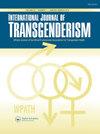Transforming the paradigm of nonbinary transgender health: A field in transition.
Q1 Social Sciences
International Journal of Transgenderism
Pub Date : 2019-07-25
eCollection Date: 2019-01-01
DOI:10.1080/15532739.2019.1640514
引用次数: 35
Abstract
It is exactly a decade ago that Sexual and Relationship Therapy published a special issue entitled “Gender Variance and Transgender Identity”, which was guest edited by Walter Bockting, former Editor-in-Chief of International Journal of Transgenderism (IJT). In his editorial Bockting wrote “[this issue] is comprised of a collection of articles that reflect a transition in this growing field from a disease-based to an identity-based model of transgender health. The disease-based model assumes that normative gender identity development has been compromised and that the associated distress can be alleviated by establishing congruence between sex, gender identity and gender role, if necessary through hormonal and surgical sex reassignment. The identity-based model assumes that gender variance is merely an example of human diversity and that the distress transgender individuals might experience results from social stigma attached to gender variance. The latter model views transgender people as having an experience, identity and sexuality distinct from those of both non-transgender women and men. This paradigm shift forms the context for nine peer reviewed articles... .” (Bockting, 2009). This special issue consists of more than double the amount of contributions than a decade ago, and concerns the area of nonbinary and genderqueer transgender health. Clearly a reflection of progress, progression and promise, albeit at a moderate pace. There is nevertheless reason for optimism. The multidimensionality and heterogeneity of gender identities and the idea that one’s gender identity can be a mix of both being a man and a woman, being somehow beyond the gender binary, or something completely else is increasingly acknowledged and recognized (Bockting, 2008; Harrison, Grant, & Herman, 2012; Herdt, 1993; K€ ohler, Eyssel, & Nieder, 2018; Kuper, Nussbaum, & Mustanski, 2012; Richards, Bouman, & Barker, 2018). In the last decade in particular, there is growing evidence that in fact there is a sizable group of people who do not identify as binary trans. In parallel, language regarding gender identities has shifted and continues to evolve (Bouman et al., 2017), and although we will use the adjective nonbinary in this editorial to refer to people who identify between, outside and beyond the gender binary, we acknowledge that this is a reductionist approach and does not do justice to the realities of nuanced gender identity categories. We are also aware that the term nonbinary may well change in academic and legal discourse, especially once the terminology chapter of the 8 version of the WPATH Standard of Care has been completed and published. In terms of the prevalence of nonbinary identities then, Harrison, Grant, and Herman (2012) found that 13% of trans respondents (N1⁄4 6436) in their US sample preferred a different identity than: male/man, female/ woman, or part time as one gender, part time an another in their community based survey; of the 860 written responses the majority of respondents wrote in genderqueer, or some variation thereof, such as pangender, third gender, or hybrid. Others chose terms that refer to third gender or genderqueers within specific cultural traditions, such as Two-Spirit (FirstNations), Mahuwahine (Hawaiian), and Aggressive (Black or African American) (Harrison, Grant, and Herman, 2012). The European LGBT Survey conducted by the Fundamental Rights Agency (2014) published data from 28 European countries showing that from their total sample of trans respondents (N1⁄4 6771), 8.7% identified as gender variant, 15.6% as queer and 20.4% as other (options also included: transgender (16.8%), transsexual (19.7%), woman with a transsexual past (5.2%), man with a transsexual past (2.1%), and cross dresser (11.4%). Those who choose “other” could add their preferred self identification: e.g., agender, bigender, dual gender, fluid gender, gender neutral, gender fluid, gender non-conformist, genderless, genderqueer, intergender, queer, neuter, no label, non-gender, pangender, polygender, third gender. Moving from highly selected online samples to general populations Kuyper and Wijsen (2014) found that 4.6% of people assigned male at birth and 3.2% of people assigned female at birth reported an ‘ambivalent gender identity’ in their Dutch population sample. An ambivalent gender identity was defined as equal identification with other sex as with sex assigned at birth. This percentage was higher than the prevalence of gender incongruent identities (stronger identification with other sex as with sex assigned at birth). Similar, albeit slightly lower percentages were reported by Van Caenegem et al. (2015) who showed that the prevalence of ‘gender ambivalence’ was present in 2.2% of assigned male at birth respondents and 1.9% of assigned female at birth respondents in their Belgian population sample. Fontanella, Maretti, and Sarra (2014) observed 8.7%转变非二元跨性别健康范式:转型中的一个领域。
本文章由计算机程序翻译,如有差异,请以英文原文为准。
求助全文
约1分钟内获得全文
求助全文
来源期刊

International Journal of Transgenderism
Social Sciences-Gender Studies
CiteScore
5.10
自引率
0.00%
发文量
0
期刊介绍:
International Journal of Transgenderism, together with its partner organization the World Professional Association for Transgender Health (WPATH), offers an international, multidisciplinary scholarly forum for publication in the field of transgender health in its broadest sense for academics, practitioners, policy makers, and the general population.
The journal welcomes contributions from a range of disciplines, such as:
Endocrinology
Surgery
Obstetrics and Gynaecology
Psychiatry
Psychology
Speech and language therapy
Sexual medicine
Sexology
Family therapy
Public health
Sociology
Counselling
Law
Medical ethics.
 求助内容:
求助内容: 应助结果提醒方式:
应助结果提醒方式:


